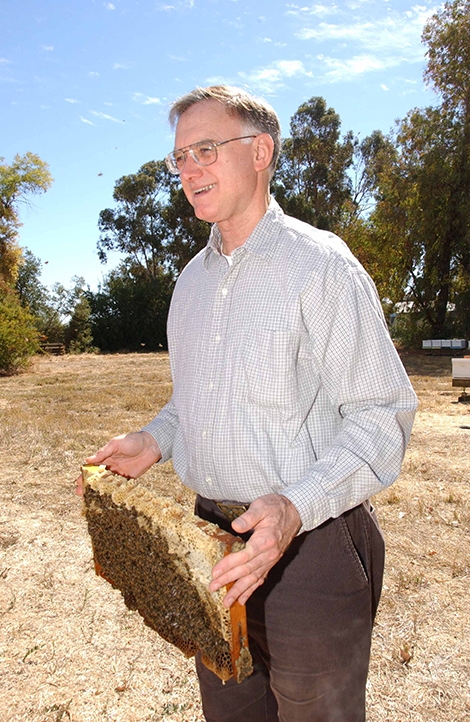
Wikipedia defines CCD as "an abnormal phenomenon that occurs when the majority of worker bees in a honey bee colony disappear, leaving behind a queen, plenty of food, and a few nurse bees to care for the remaining immature bees."
We were going through materials this week for the Celebration of Life and Legacy for UC Extension apiculturist Eric Mussen of the UC Davis Department of Entomology and Nematolgy, when we ran across his Oct. 9, 2007 presentation delivered as part of the UC Davis Department of Entomology's Distinguished Seminar Series.
We covered his seminar, which drew a capacity crowd and scores of questions. We still have his PowerPoint.
The news story bears repeating:
UC Davis honey bee specialist Eric Mussen fingered a line-up of prime suspects at his “BSI: The Case of the Disappearing Bees” lecture on Oct. 9, part of the UC Davis Department of Entomology's Distinguished Seminar Series.
Mussen identified malnutrition, parasitic mites, infectious microbes and insecticide contamination as among the possible culprits. It's a complex issue, he said, but one thing is certain: “It seems unlikely that we will find a specific, new and different reason for why bees are dying.”
Colony collapse disorder (CCD), a phenomenon where bees mysteriously abandon their hives, is not a new occurrence, said Mussen, the Extension Apiculturist at UC Davis since 1976.
“Similar phenomena have been observed since 1869,” he said. “It persisted in 1963, 1964 and 1965 and was called Spring Dwindling, Fall Collapse and Autumn Collapse. Then in 1975, it was called Disappearing Disease.”
“But the disease wasn't what was disappearing,” Mussen quipped. “The bees were."
Massive bee die-off also occurred during the winter of 2004-05, but only those who read bee journals knew about it, Mussen told the crowd in the campus Activities Recreation Center. The latest die-off caught the attention of the national media last fall when a Pennsylvania beekeeper asked researchers at Pennsylvania State University to look at samples of his dying bees in Pennsylvania and Florida. “The local media picked up the story and the rest is history, including yours truly on the Lehrer Hour.”
One-third of America's honey bees vanished this past year due to the mysterious CCD, characterized by almost total hive abandonment. Nearly all adult worker bees unexpectedly fly away from the hive, abandoning the stored honey, pollen, larvae and pupae. Usually they leave in less than a week, and only the queen and a few young workers remain, Mussen said.
Honey bees normally do not abandon their brood, he said. “Nurse bees” continually feed the young, which increase 1,000-fold in size in six days.
“That's like an 8-pound baby weighing 4 tons in six days,” Mussen said.
Mussen, who received the American Association of Professional Apiculturists' excellence award in January for his bee industry leadership and apicultural research publications, and was named the California State Beekeepers' Association's 2006 “Beekeeper of the Year” for his industry-wide contributions, finds the silence of the bees troubling.
“The real reason bees are important is that we rely on them for crop pollination,“ he said. Commercial honey bees pollinate about 90 of the country's crops, valued at $15 billion.
“One third of our U.S. diet depends on honey bees,” Mussen said. “If bees produce fruits and vegetables somewhere else, do we (Americans) want to be as dependent on food as we are on oil?”
Bees are especially crucial to California's 600,000 acres of almonds, he said. To pollinate the almonds, growers need 1.2 million bee hives, “but California doesn't have 1.2 million bee hives, so they have to be trucked here.”
That, he said, can add to the bee stress.
Mussen linked malnutrition as a key factor in CCD. Honey bee nutrition is “weather dependent,” he said. “The best-fed bees are the healthiest, while malnourished bees are less resistant.”
Malnutrition and climate-linked issues include: Did local weather events affect pollen-producing plants negatively?
- Was there a lack of bloom (nectar and pollen) due to lack of rain or too much heat?
- Was there reduced access to flowers due to excess rain?
- Did cold nights interfere with meiosis that led to “sterile” or “non-viable” pollens?
- Do these types of pollen contain the usual proteins, vitamins, minerals and lipids required by the bees?
Mussen said that many regions in the United States experienced significant drought in 2006. “The U.S. honey crop was off 11 percent, one of the lowest on record. The California crop was off 30 percent; North and South Dakota crops were off nearly 15 and 40 percent respectively.”
If there's malnutrition in August and September, that adversely affects the winter bees, he said. A mix of quality pollens is required to rear healthy winter bees.
Unlike the California definition based on amount of water in the reservoirs, the beekeepers' definition of drought is: Is there enough soil moisture to keep the flowers growing? "This year there was not,” Mussen said.
Malnourished bees are more susceptible to disease, predators and insecticides, he pointed out. The Varroa destructor mites, introduced here in 1987 from the Asian bee (Apis cerana), spread across the country in five years, killing the American bee (Apis mellifera), known as the European bee.
Compared to fruit flies and mosquitoes, “bees have a limited immune system; they're pretty anemic,” he said.
Another problem: “Varroa mites have become resistant to most legal chemical controls that used to keep them in check.”
Mussen cast suspicion on several viruses as CCD factors: the Kashmir bee virus, acute bee paralysis virus, deformed wing virus, black queen cell virus and the Israel acute paralysis virus.
“Honey bees have about 20 known viruses, most of which can cause disease,” he said. Some viruses remain latent, just like chicken pox in humans, which can show up as shingles later in life.
USDA scientists found the Israeli acute paralysis virus, in nearly all of the CCD colonies they tested, but none in the control group. In addition, they found the Kashmir bee virus in all the CCD colonies tested.
Also found in all the CCD colonies tested were the infectious microbes Nosea ceranae and Nosema apis. N. ceranae, a relatively new fungal disease of American honey bees, was imported from the Asian honey bee, Apis cerana. N. apis, its American counterpart, has been around for at least a century.
A favorite suspect among the beekeepers is neonicotinoids, chemicals designed to mimic the toxic effects of a neurotoxin from the tobacco family. The nicotine-like insecticide kills fleas on cats and dogs, and is used as a seed treatment and in side dressing and foliar spray applications.
“The insecticides enter various plant tissues and become distributed, systemically, throughout the plant,” he said. “Nicotine is so toxic to humans that if you put a drop of pure nicotine on your finger, you're dead.”
Neonicotinoids have been formulated to be nearly non-toxic to mammals, birds, and fish but remain extremely toxic to invertebrates.
Laboratory studies showed that miniscule doses of neonicotinoids increased the rate of learning in bees, but at high doses, bees failed to respond to training.
“It wasn't memory loss; it was intoxication,” Mussen said. “They were drunk.”
Another suspect: Gaucho® (imidacloprid), used as a seed treatment on sunflowers. Beekeepers claimed that when bees visited sunflowers, they never returned to their hives; “they lost their memory.” France and Spain banned imidacloprid, but “bees are still failing in their hives,” Mussen noted.
Mussen said no scientific documentation exists to blame imidacloprid for the bee die-off. A study found only 5 parts per billion maximum in the nectar of sunflowers and canola, he said. The Bayer fact sheet indicates that the insecticide is toxic to honey bees at 192 ppb.
Among the more “quirky” explanations for CCD: cell phone usage, alien encounters, honey bee “rapture” (where hive populations “ascend to that big honeycomb in the sky en masse”); and chemtrails, aircraft-released vapors.
“Some thought chemtrails was a military-industrial complex plan to kill all children and old people — and got the bees and birds by mistake,” Mussen said.
Mussen said he hopes that the current fascination with honey bees will lead to more research and more research funding. (End of story)
(Editor's Note: Dr. Mussen, a 38-year California Cooperative Extension apiculturist and an invaluable member of the UC Davis Department of Entomology and Nematology faculty, died Friday, June 3 at his home in Davis. He was 78. Attendance to the UC Davis-sponsored event celebrating his life and legacy is closed, but UC Davis distinguished professor Walter Leal will live-stream the event on Zoom. It will be permanently housed on YouTube. Registration for the Zoom webinar is underway at https://bit.ly/3dIyAhG. The YouTube account is at https://youtu.be/Kj5NuQ_rBuo. The webinar starts at 4 p.m. on Sunday. Aug. 28.)
Attached Images:
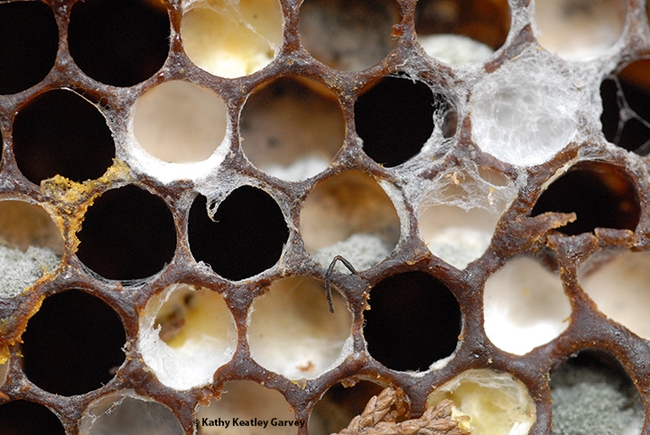
Close-up image of cells in an abandoned hive; colony collapse disorder suspected. Note the bee antenna near the center. And the mold. (Photo by Kathy Keatley Garvey)
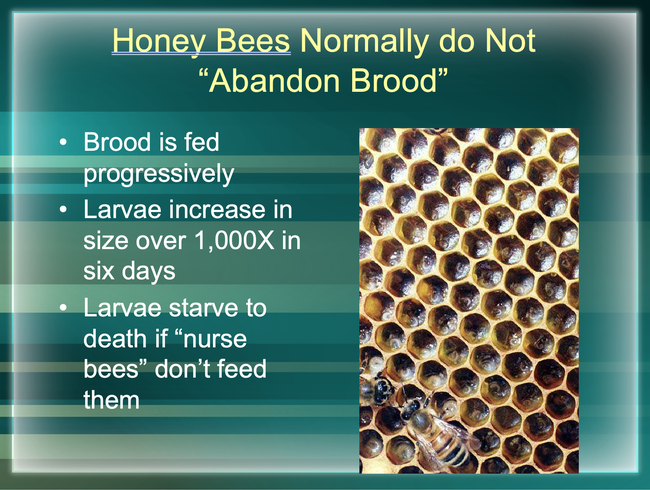
One of the slides in Eric Mussen's presentation on colony collapse disorder.
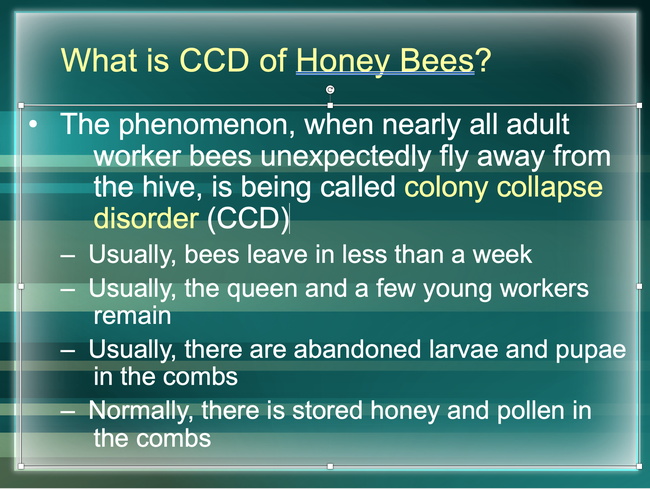
Extension apiculturist Eric Mussen briefly explained colony collapse disorder in this slide.
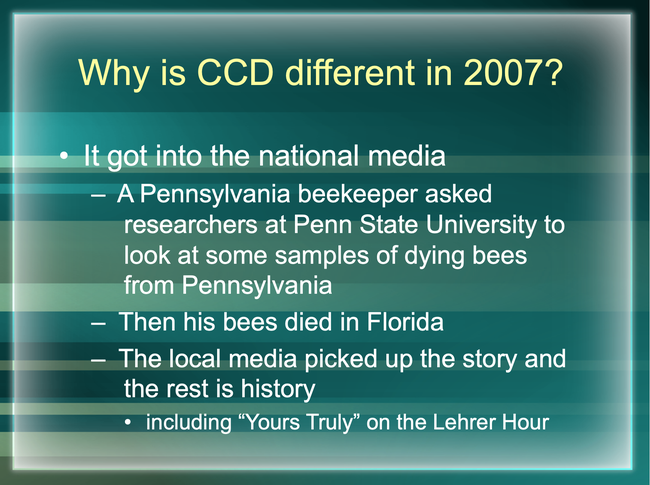
In this slide, Extension apiculturist Eric Mussen explained what sparked the colony collapse disease fury.
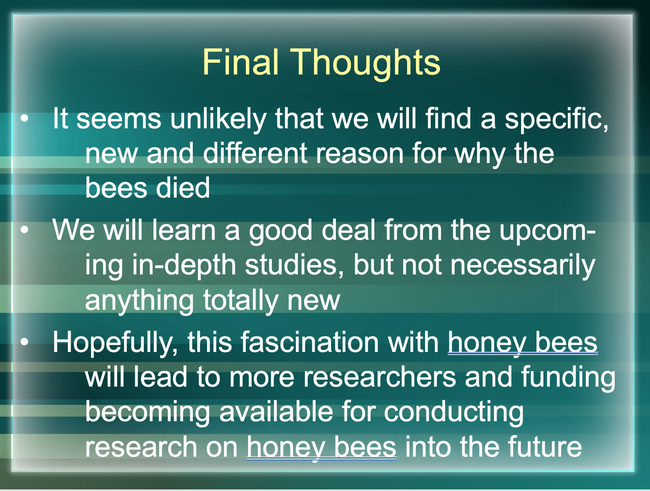
Extension apiculturist Eric Mussen detailed final thoughts about colony collapse disorder in this slide.